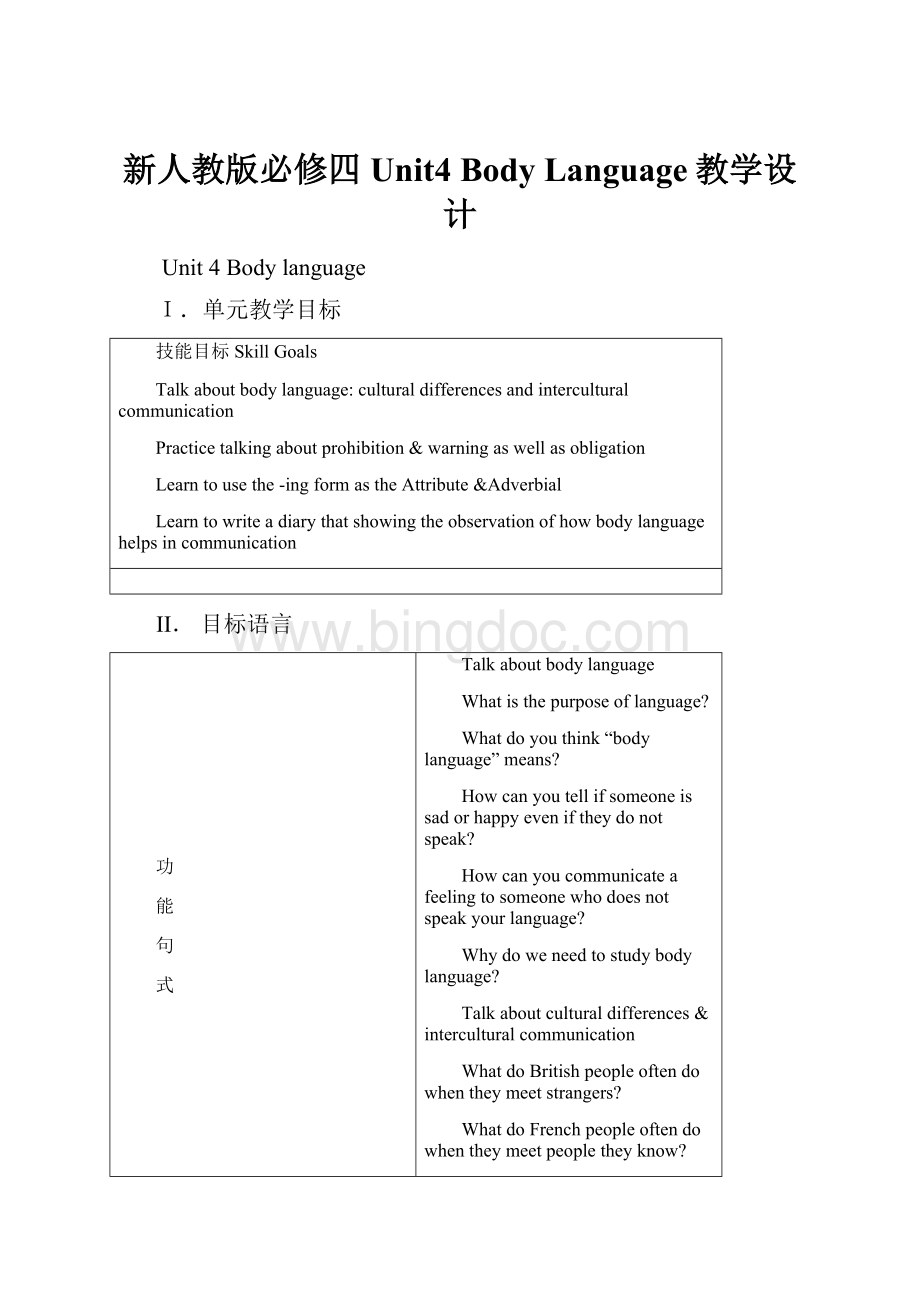新人教版必修四Unit4 Body Language教学设计.docx
《新人教版必修四Unit4 Body Language教学设计.docx》由会员分享,可在线阅读,更多相关《新人教版必修四Unit4 Body Language教学设计.docx(29页珍藏版)》请在冰点文库上搜索。

新人教版必修四Unit4BodyLanguage教学设计
Unit4Bodylanguage
I.单元教学目标
技能目标SkillGoals
Talkaboutbodylanguage:
culturaldifferencesandinterculturalcommunication
Practicetalkingaboutprohibition&warningaswellasobligation
Learntousethe-ingformastheAttribute&Adverbial
Learntowriteadiarythatshowingtheobservationofhowbodylanguagehelpsincommunication
II.目标语言
功
能
句
式
Talkaboutbodylanguage
Whatisthepurposeoflanguage?
Whatdoyouthink“bodylanguage”means?
Howcanyoutellifsomeoneissadorhappyeveniftheydonotspeak?
Howcanyoucommunicateafeelingtosomeonewhodoesnotspeakyourlanguage?
Whydoweneedtostudybodylanguage?
Talkaboutculturaldifferences&interculturalcommunication
WhatdoBritishpeopleoftendowhentheymeetstrangers?
WhatdoFrenchpeopleoftendowhentheymeetpeopletheyknow?
Whyshouldwebecarefulaboutourownbodylanguage?
Whyisitimportanttowatchothersaswellaslistentothem?
词
汇
1.四会词汇
Represent,association,canteen,dormitory,flight,curious,approach,major,misunderstand,dash,adult,crossroad
2.认读词汇
unspoken,,Jordan
3.词组
belikelyto,ingeneral,notall,turnone’sbackto,loseface
语
法
4.重点词汇
represent,introduce,approach,touch,express,nod,avoid,misunderstand,punish,general,curious,similar,expression,agreement,gesture,action
The-ingformastheattribute&&adverbial
Findingoutinthereadingtextsentenceswithpresentparticiple(s)usedastheattributeoradverbial.
1.The-ingformastheattribute
Theyarevisitorscomingfromseveralothercountries,...
HisnosetouchesMr.Cook’smovinghand,...
Thisisanexcitingexperienceforyou,...
2.The-ingformastheadverbial
...soyoustandwatchingandlistening.
Fourpeopleenterlookingaroundinacuriousway.
Youseeherstepbackappearingsurprised,andtakeafewstepsawayfromMr.Garcia.
ThevisitorfromJapancomesinsmilingatthesametimeasGeorgeCookfromCanada.
Ⅲ.教材分析和教材重组
1.教材分析
本单元以BodyLanguage——“体态语”为中心话题,具体涉及什么是“体态语”,如何理解“体态语”,以及“体态语”的跨文化性等。
本单元的语言技能和语言知识也都是围绕“体态语”这一中心话题设计的,旨在通过单元教学,用听、说、读、写、做(表演)等多种形式,让学生正确认识和掌握“体态语”在交际中的作用和意义,使学生明确“体态语”在人类交际中的重要性,了解“体态语”在不同民族、不同文化交际中的多样性;使学生在今后的日常生活、学习、工作和交往中尽量减少或避免运用“体态语”时可能产生的误解,提高他们的“语言交际”能力和“非语言交际”能力。
1.1WARMINGUP以列表对比(填充及增补)的形式,并通过WARMINGUP的活动,让学生了解有声语言与“体态语”的对应关系,了解语言意义与行为意义(“体态语”)在交际中具有同等重要的作用。
同时,学生在听、说、做(即表演“体态语”的动作)中能够增进对语言交际的感性认识,为他们在阅读过程中上升到对语言交际的理性认识打下基础。
1.2PRE-READING通过提供三个关于不同文化背景下“体态语”的问题,启发学生思考我们所学习的“语言”的目的、形式、功能。
通过引导学生联系自己日常生活的实际,提高学生努力学习英语的积极性和自觉性;同时培养学生留心社会、关注生活的洞察力,为引导学生进一步“阅读”作好准备。
1.3READING是一篇介绍性(记叙文)体裁的文章,主要介绍了各种文化背景下的“体态语”的异同,为学生提供了来自不同国度、不同语言文化背景的“体态语”及其在交际中的异同和影响的具体例证。
学生也可以结合自己在语言交际中所遇到的实际例子来进一步理解“交际,毫无问题可言吗?
”这一主题。
1.4COMPREHENDING包括八个问题(前5个旨在检查学生对阅读材料细节的理解,6~7旨在引导学生对“体态语”的意义及文化差异的思考,第8个检查学生能否通过细节进行推理判断),通过对来自不同国度、不同语言文化背景的六个角色对待男女不同性别所使用的“体态语”异同的(学生在老师指导下的自我或小组讨论后的)归纳,进一步熟悉和掌握“体态语”在不同语言文化交际中的作用和意义。
1.5LEARNINGABOUTLANGUAGE分词汇和语法两部分。
词汇部分由“本单元重点词汇英文释义”,“词语填空”和“词性变换”三项内容构成,语法部分由两大方面组成:
一是让学生自己通过在课文中寻找相关语法的句子并按其语法功能分类,二是根据学生的认知规律安排该语法项目的练习让学生进行操练。
整个项目通过三个练习和一个游戏,以及语法结构讲练,进一步巩固本单元所学词汇(尤其是课文中的黑体字),学习“现在分词”结构用作定语和状语,并通过操练,以收到“学以致用”、“熟练生巧”的效果。
1.6USINGLANGUAGE通过增加阅读篇目“ShowingOurFeelings”来拓展学生在“体态语”方面的知识视野,并通过“True”or“False”判断练习和问题讨论,使学生进一步明确“体态语”对人们在日常交际中了解对方情感、思想、态度等方面所起的作用。
同时要让学生认真对待自己的“体态语”,并在日常交际中“听其言”(Listentothem)、“观其行”(Watchthem)。
此外,该部分还通过听、说、读、写四个方面来巩固本单元所学内容和语言交际项目。
1.7SUMMINGUP师生从话题、词汇和结构三个方面来共同总结本单元所学的单词和短语,语言及语法项目,总结本单元所学的主要内容和收获。
1.8LEARNINGTIPS建议学生关注实用交际技巧,学会“体态语”;建议学生在看英语电影时或与以英语为母语的人士交谈时,观察对方面部表情和体态姿势,观察对方的“言”、“行”,进而形成有效的口笔头语言及“体态语”的交际能力。
2.教材重组
2.1听力:
Usinglanguage中的Listening,Workbook中的Listening和ListeningTask这三部分的任务及话题较为接近,将这三个部分整合在一起上一堂听力课。
2.2口语:
Warmingup,Usinglanguage中的ReadingandTalking,Speaking和Workbook中的Talking,SpeakingTask以及Learningaboutlanguage中的Discoveringusefulwordsandexpressions4,“Playagameingroupoffour”均紧扣本单元话题,同时涉及到本单元的功能句,教师可指导学生通过“说”(用英语发出与“体态语”相关的指令)与“做”(用“体态语”表达指令)结合来进行口语训练,这将是一节生动有趣的口语课。
2.3精读:
把Pre-reading,Reading和Comprehending三部分整合为一节阅读课。
2.4泛读:
把UsingLanguage中的Reading和Workbook中的ReadingTask整合为一节拓展学生视野的泛读课。
2.5语言学习:
深入处理Learningaboutlanguage中的Discoveringusefulwordsandexpressions,Discoveringusefulstructures;Workbook中的UsingWordsandExpressions和UsingStructures。
重点学习Discoveringusefulstructures中“-ing(现在分词)”在句中做定语和状语的用法。
2.6语言运用:
处理UsingLanguage中的ReadingandWriting和Workbook中的WritingTask。
指导学生写一篇有关“TheBodyLanguageIKnow”短文,反映其在不同文化背景、不同语言环境中的运用情况,及所造成的理解上的困难、障碍甚至误解等。
3.课型设计与课时分配
1stperiodSpeaking
2ndperiodReading(I)
3rdperiodReading(II)
4thperiodLanguageStudy
5thperiodListening
6thperiodWriting
Ⅳ.分课时教案
TheFirstPeriodSpeaking
Teachinggoals教学目标
1.TargetLanguage目标语言
a.重点词汇和短语
misunderstand,similar,facial,expression,agreement,yawn,chest,gesture,adult,punish
b.重点句型或交际用语
Actoutthefollowingmeanings,please.
PleaseguesswhatImean.
Pleaseshowtheactions,usingbodylanguage.
Nowitisyourturntoshowtheaction/gesture.
Pleaseuseeitherspokenwordsorbodylanguagetoexpressyourideas.
Pleaseusebothspokenwordsandbodylanguagetoexpressyourideas.
2.Abilitygoals能力目标
a.Enablethestudentstounderstandwhatacertaingestureofthebodylanguagemeansinagivensituation.
b.Enablethestudentstoactoutsomemeanings,requirements,requestsorsituationsgiveninthetargetlanguage.
c.Enablethestudentstoexpresswiththetargetlanguagethemeaningsgiveninbodylanguage.
3.Learningabilitygoals学能目标
a.Helpthestudentslearnhowtoexpressthemselvesinbodylanguagewhenneeded.
b.Helpthestudentsunderstandotherswhenbodylanguageisbeingused.
Teachingimportantpoints教学重点
a.Teachthestudentshowtounderstandbodylanguageusedindifferentcountriesorculturesaswellasindifferentoccasions.
b.Teachthestudentshowtousebodylanguageinthemostappropriateoccasions.
Teachingdifficultpoints教学难点
a.Enablethestudentstorealizetheimportanceofbodylanguageincommunicationsothatlittleornomisunderstandingmayoccur.
b.Letthestudentsknowthatthereisbothpositivebodylanguageandnegativebodylanguage.
Teachingmethods教学方法
a.Individualwork,pairworkandgroupwork.
b.Actingoutbyimitation,mimeorwithgesturesandbodymovement.
Teachingaids教具准备
Acomputer,aprojectorandsomepictures.
Teachingprocedures&ways教学过程与方式
StepILead-in
Theteachershowssomepicturesonscreen.ThesepicturesarefromtheEveningPartyCelebratingthecomingLunarNewYearoftheRoosterof2005.
Ss:
Yes,ThousandsofHandsKwan-yin.
T:
Butdoyouknowwhosheis?
Yes,shewastheleadingdanceroftheprogram.HernameisTaiLihua(邰丽华).SheiscalledaFairyofPeachblossom(桃花仙子)bypeople.Youknowsheisadeafgirl,butsheisawise,diligent,charmingandenergeticgirl.Shestudiedveryhardandgottwodegreesofbachelorsinuniversity.Shewasfamousasanartistforherwonderfulperformance.Sheisdeafanddumb.Buthowdidshegetthatgreatachievementandbecameasuccessfulperson?
Sheloveslifeverymuch.Weshouldlearnfromherspirit.Besidesherhardworking,bodylanguageplaysaveryimportantpartinherlife.Weareallhealthypeople,sometimeswecanusebodylanguagetoexpressourselves.Soweshouldpaymoreattentiontolearningbodylanguages.
StepIIIntroduction
T:
Nowlet’sdosomeTPR(TotalPhysicalResponse)activitiestogether,Ihopeyouwillenjoythemandhavefunaswell.
Touchyourhead/face/eyes/nose/mouth/ears/cheeks/forehead/shoulders/stomach/legs/feet/toes...
Shakeyourhead/arm/hand...
Waveyourarm/hand...
Openyoureyes/arms/mouth...
Closeyoureyes/mouth...
Twistyourwrist/waist.
Crossyourarms/fingers.
Nodyourhead.Bowyourhead.
Makeafacetoeachother.
Bend/cry/shout/scream/smile/laugh...
T:
Allright.Nowlet’sdothemalittlebitdifficult.Let’splayagametogether.Thosewhofailtofollowtheruleofthegamewillbedroppedout.Thegameis:
“Simonsays”.Forexample,ifIsay“Simonsays,touchyourhead”,thenyoutouchyourhead.Ifnot,youshouldn’ttouchyourheadbutremainstill.Clear?
Ready?
Nowlet’sstart.
3or5minutesforthegame.
T:
Ok.It’stimetotakeupthelesson.Pleaselookatthescreen.Let’stakealookatthefollowinggestures:
Gesture
Action
Meaning
Ahandshake
Youarewelcome.
Aclapofhand
Comeon;becheerful.
AV-shapeofthefore-fingerandmiddlefinger
Mayyousucceed!
Orcongratulationsonyoursuccess!
Ahalf-closedhandwiththumbdown
IamnotinfavorofyourideaorI’llhavetorefuseyou.
Awrinklingofthebrowinthoughtordispleasureorascowl
Sheisworried.
Tearscomingoutofhiseyes.
Heisverysad.
Allsmilesonherface
Sheisveryhappy.
Wavingtheirhands
Theyarewavinggoodbyetopeoplearound.
Ahandstretchedoutforwardwithstrength
Heisstoppingatank.
Peoplejumpwiththeirbothhandsstretchedopenintheair.
Theyarecheeringforthevictory.
T:
Whataretheactionsoftheabovegestures?
Whatdotheymean?
S4:
Thefirstgestureisahandshake,whichmeans“You’rewelcome”.
S5:
Thesecondisahandclap,whichmeans“Comeon”or“Becheerful”orsomethinglikethat.
S6:
ThethirdoneisaV-shapedpostureofthefirstfingerandthemiddlefinger,whichsuggestsawishfortheotherorotherstosucceed.
S7:
Thefourthisahalf-closedhandwiththethumbdown.Itmeanstheonewhogivesthisgestureisagainsttheother’sideaorsimplyrefusestherequest.
S8:
Thefifthisaworriedlookofawoman.Shewrinklesherbrowsorfrowns.Italsoseemsthatshescowls.Itshowsthatsheisworriedorsad.Inotherwords,sheis